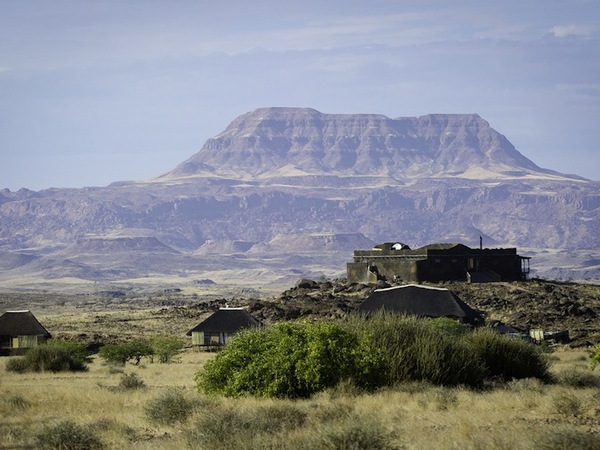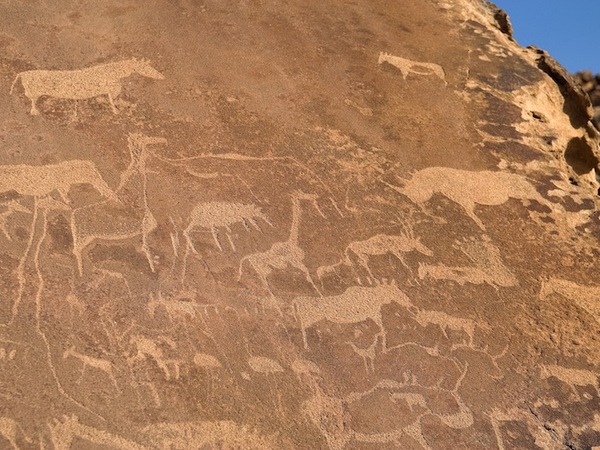Doro Nawas
traditional Camp | Damaraland, Namibia
Click here to be the first to review Doro Nawas
Doro Nawas Camp is situated in the ruggedly beautiful Damaraland area, resting atop a rocky knoll within the floodplain of the Aba-Huab River Valley in northwest Namibia. This is prime habitat for desert-adapted elephants. The unique lodge design allows for an uninterrupted panorama of this diverse and dramatic landscape, with imposing plateaus, canyons, dry riverbeds, and open savanna. Dark, clear nights offer superb stargazing from camp.

Our Expert Says
I actually chose the location for this comfortable camp, so I can offer some insight! This is the perfect site to access both the desert-adapted elephant herds of the Huab River and the wonderful San petroglyphs of Twyfelfonteine. The camp enjoys mesmerizing vistas across the dry riverbed to the sandstone cliffs and basalt mountains beyond.
– Ben Forbes

The Camp
Location: Damaraland, Namibia
Number of Tents: 16
Doro Nawas Camp is located in a dry river valley within the Doro !Nawas Conservancy in central Damaraland, commanding spectacular views of the Etendeka Mountains to the north and the red sandstone cliffs of Twyfelfontein in the south. Guests stay in 16 units that combine natural stone and canvas walls with wood and glass doors, shaded by a thatch roof. Each unit was designed to blend harmoniously with the natural surroundings and includes a bedroom that leads out to a private veranda, en suite facilities, an outdoor shower, and a staircase up to a private rooftop terrace where guests have the option of sleeping beneath some of the most staggeringly starry night skies on earth. The main area of Doro Nawas Camp is perched atop a sparse, rocky knoll and provides guests with unspoiled panoramic views of the magnificent desert landscape. It features indoor and outdoor rooftop dining areas, bar, pool, curio shop, small gallery and a picturesque courtyard.

Facilities & Amenities
- En suite bathroom with indoor/outdoor showers
- Family Accommodation: 1 family unit with 2 en suite bedrooms each with private entrances connected by shared deck (no outdoor showers)
- Shampoo, soap, and insect repellent
- Room fan
- 220v charging outlets in room
- In-room safe
- Central pool
- Star bed deck
- Laundry included
- Local drinks included (house alcoholic and non-alcoholic drinks)
- Credit cards accepted (Visa and MasterCard)
- No air conditioning, hair dryer, telephone, Internet or cellular coverage

Wildlife Viewing & Activities
Activities include nature drives and guided walks to absorb the spectacular views and desert scenery. Rare succulent plants somehow manage to eke out an existence in this harsh landscape, and the wide-open terrain may reveal sightings of the rare desert-adapted elephant, gemsbok, springbok, ostrich and other hardy desert animals. Though rare, lion, cheetah, and spotted and brown hyena also occur here, as do endangered black rhino and bat-eared fox. The area also boasts excellent birdwatching, with more than 240 species in the surrounding conservancy, including raptors such as martial eagle, lappet-faced vulture and pale chanting goshawk. A highlight is the fascinating expedition to Twyfelfontein, recently proclaimed a World Heritage Site, with its renowned San art engravings, and the largest collection of petroglyphs—prehistoric rock art—in Africa. A visit to the Damara Living Museum reveals the rich traditional culture of the local Damara people.
Damaraland has varying concentrations and species of wildlife, and the below chart helps to illustrate major wildlife sightings often experienced in the area. Unique and common sightings in addition to the desert-adapted elephant and rhino may include ostrich, Hartmann’s mountain zebra, springbok, and occasionally predators. Over 240 species of bird thrive here. Exact sightings will depend on water availability and wildlife movements.
| Country | Park/Reserve |
Black Rhino
|
Cheetah
|
Elephant
|
Gemsbok / Oryx
|
Giraffe
|
Greater Kudu
|
Lion
|
Zebra
|
|
|---|---|---|---|---|---|---|---|---|---|---|
| Namibia | Damaraland |
| Usually viewed | Frequently viewed | Occasionally viewed | Sporadically viewed | Rarely to never viewed |
Climate
| Month | Max | Min | Rainfall |
|---|---|---|---|
| January | 64° F | 59° F | 1.77 in |
| 17° C | 15° C | 45 mm | |
| February | 66° F | 61° F | 2.2 in |
| 18° C | 16° C | 56 mm | |
| March | 66° F | 61° F | 2.72 in |
| 18° C | 16° C | 69 mm | |
| April | 64° F | 57° F | 0.91 in |
| 17° C | 13° C | 23 mm | |
| May | 66° F | 55° F | 0.16 in |
| 18° C | 12° C | 4 mm | |
| June | 64° F | 55° F | 0.04 in |
| 17° C | 12° C | 1 mm | |
| July | 63° F | 52° F | 0.12 in |
| 17° C | 11° C | 3 mm | |
| August | 61° F | 52° F | 0.12 in |
| 16° C | 11° C | 3 mm | |
| September | 61° F | 52° F | 0.16 in |
| 16° C | 11° C | 4 mm | |
| October | 69° F | 54° F | 0.51 in |
| 20° C | 12° C | 13 mm | |
| November | 63° F | 54° F | 0.83 in |
| 17° C | 12° C | 21 mm | |
| December | 63° F | 57° F | 0.55 in |
| 17° C | 13° C | 14 mm |

Conservation
When you stay at Doro Nawas Camp, you are supporting a pioneering community development and conservation initiative. The million-acre Doro Nawas Conservancy is a joint venture between Wilderness Safaris and 450 community stakeholders and is widely acknowledged as a shining example of modern, high-income, low-impact, community-based ecotourism. The formation of the conservancy has resulted in substantially increased and stabilized populations of desert wildlife and the realization of significant social and economic benefits to the local community and its members who serve as conservancy landlords and who together hold a 40% share in Doro Nawas Camp. The community directly benefits from the camp in a variety of ways: it receives a percentage of the camp’s revenue, and through the camp community members receive jobs and in-depth training in all aspects of tourism management. In addition, the camp provides revenue to local businesses through the provision of necessary goods and services.
Reviews for Doro Nawas
Review Doro Nawas No reviews for Doro Nawas Click here to be the first to review Doro Nawas





























